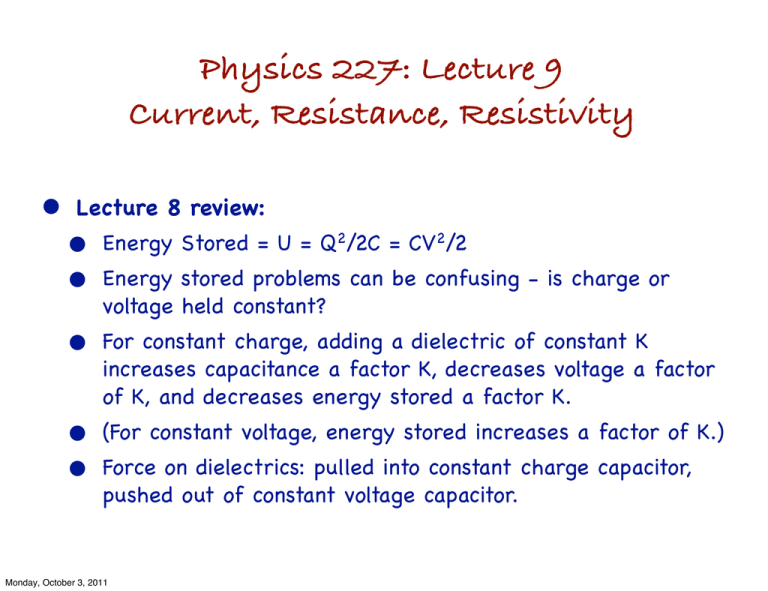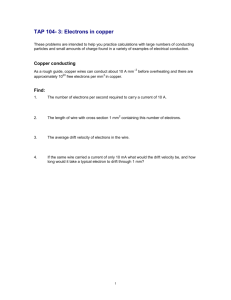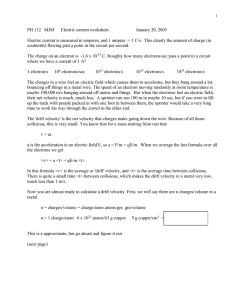Notes
advertisement

Physics 227: Lecture 9 Current, Resistance, Resistivity • Lecture 8 review: • • Energy Stored = U = Q2/2C = CV2/2 • For constant charge, adding a dielectric of constant K increases capacitance a factor K, decreases voltage a factor of K, and decreases energy stored a factor K. • • Energy stored problems can be confusing - is charge or voltage held constant? (For constant voltage, energy stored increases a factor of K.) Force on dielectrics: pulled into constant charge capacitor, pushed out of constant voltage capacitor. Monday, October 3, 2011 • • Fields in Conductors Earlier we have said that there is no field inside a conductor. If there were a field, the electrons would be forced to move, and would do so until they arranged in a pattern that made the internal field vanish. • But there has been a somewhat hidden assumption here. • We have no energy source that continues to supply energy the electrons around. For example... + + + + + - - - - - Capacitor to move Connect a wire between the plates of a capacitor. There is a voltage across it. Electrons will move until the capacitor is neutral. Use instead a battery and electrons move for a long time. In a conductor, electric field Monday, October 3, 2011 current. Moving Charges • In conductors and many semiconductors, the moving charges are the electrons. The positive ions (atoms missing an electron) are generally fixed. ee+V • In some semiconductors, positive ``holes’’ are the charge carriers. • In solutions and gases, the charge carriers can be positive charges, or negative charges, or both. • The motion is not the smooth cartoon pictured. Electrons scatter from the more or less fixed atoms. You might picture a small drunk person weaving through a crowd of still large people. Monday, October 3, 2011 E ee-V Current iClicker If there is an E field, there is continually acceleration. The electrons must then accelerate and get increasing speed, leading to a continually increasing current. Why doesn’t this happen? A. The electric field E is only nonzero outside the conductor, so the electron velocity is constant inside. B. When the electrons scatter, on average their velocity is ≈0, so they never get that fast between scatterings. C. The current does not increase when the electrons move faster. D. When the electrons scatter, some of them keep going backwards. E. The question is wrong - it does happen. Monday, October 3, 2011 Current iClicker If there is an E field, there is continually acceleration. The electrons must then accelerate and get increasing speed, leading to a continually increasing current. Why doesn’t this happen? A. The electric field E is only nonzero outside the conductor, so the electron velocity is constant inside. B. When the electrons scatter, on average their velocity is ≈0, so they never get that fast between scatterings. C. The current does not increase when the electrons move faster. D. When the electrons scatter, some of them keep going backwards. E. The question is wrong - it does happen. Monday, October 3, 2011 BUildup of Charge? • eIs there a buildup of charge? e- ee- +V • The motion of charges does not require a buildup of charge. • When we consider the steady motion of charges, there is no buildup of charge. We have a complete path, and charges circulate around it. • In poor analogy, like the emotion of cars on a street with no traffic lights or stop signs. e e • Note that we will have situations in which current is e not steady and charge builds e up - like the charging of a capacitor. Monday, October 3, 2011 -V bulb DEMO V • The light bulb is an indicator of current. a b • If the circuit is not complete air is between points a and b there is no current flow. • Put in some water, and the circuit is complete. Current flows. • Tap water contains + and - ions that are the charge carriers. E.g.: salt breaks up into Na+ Cl-. Monday, October 3, 2011 Current • I = ∆Q/∆t, in Amperes = Coulombs/second. A ee- charge e, constant common velocity vd, and wire cross sectional area A. There is a current density j = nevd, in Amperes/m2. There is a current I = neAvd∆t/∆t = neAvd. Monday, October 3, 2011 e- +V -V Positive direction: from +V to -V • Current I > 0 if: • +Q moves in + direction. • -Q moves in - direction • Current I < 0 if: • +Q moves in - direction • -Q moves in + direction • Assume a constant charge density n per unit volume, • • e- Current iClicker e- e+V e- e- e- wire A B. Drift velocity VD. C. Current density j. D. Current I. Assume a constant charge density n per unit volume, charge e, constant common velocity vd, and wire cross sectional area A. E. Charge density n. • There is a current density j = nev , in Coulombs/(m s). • There is a current I = neAv ∆t/∆t = neAv . 2 d Monday, October 3, 2011 d -V A. The electric field E. There may be more than 1 right answer. d e- wire B What is kept constant as the current flows in wire A and wire B? • e- Current iClicker e+V e- e- wire A What is kept constant as the current flows in wire A and wire B? There may be more than 1 right answer. • Charge density is a property of the material and does not change. Current is constant so there is no buildup of charge. The current density then has to change since j = I/A. The drift velocity then has to change since j = nqvd. The electric field then has to change since the drift velocity depends on the electric field. Monday, October 3, 2011 e- e- e- e- wire B -V A. The electric field E. B. Drift velocity VD. C. Current density j. D. Current I. E. Charge density n. Current as a vector and Drift velocity • There is a current I = neAv ∆t/∆t = neAv . • So current is a vector... but • as the electrons move along a wire, they regularly scatter d • • from atoms and are re-accelerated by the electric field. As the wire bends the current changes direction So while the magnitude of the current is a concern the direction may be unimportant. E e Ahhhh! emg Air resistance leads to terminal velocity Monday, October 3, 2011 d e- Atomic scattering / resistance leads to terminal velocity for electrons: vD. Ohm’s Law • As the electrons scatter from E e- e- e- Atomic scattering / resistance leads to terminal velocity for electrons: vD. the atoms recoil - they gain kinetic energy • The wire heats up. • The distance between collisions depends on the structure of the material. The drift velocity is proportional to the electric field. • Bigger E → larger a → bigger v before next collision in same distance • We define a resistivity by relating the current density j to the electric field E: current density j = nevd = E/ρ • Units of ρ = E/j: (V/m) / (A/m2) = Vm/A = Ωm, with 1Ω = 1V/A Monday, October 3, 2011 Resistivity and conductivity Resistivity is a measure of how difficult it is to accelerate electrons / how much they scatter off atoms / what the drift velocity is. low resistivity: large current for applied E large resistivity = small current for applied E One can also use conductivity σ = 1/ρ, the same symbol but NOT the same meaning as surface charge density. Monday, October 3, 2011 Temperature Dependence Resistivity generally depends on temperature. A simple picture: when conductors are warmer, the atoms vibrate back and forth more, so they appear bigger and cause more scattering of electrons. So typically resistivity increases with temperature. For semiconductors, the main effect is that as the temperature increases, the density of charge carries increases (more electrons are free to move), so the resistivity decreases. Monday, October 3, 2011 Typical resistivities metals ρ(Ωm) α(oC)-1 Cu 1.72x10-8 0.00393 Al 2.75x10-8 0.0039 W 5.25x10-8 0.0045 nichrome 100x10-8 semiconductor Si 2300 insulator ≈1015 S 0.0004 coefficient for temperature dependence or resistivity: ρ(T) = ρ0 [1+α(T-T0)] Monday, October 3, 2011 Superconductivity In 1911, Onnes discovered superconductivity - below some temperature around a few 20 K, depending on material, resistivity = 0 (for some materials). Need to be cooled with liquid He (about 4 K). Explained (Bardeen, Cooper, Schreiffer) as from Cooper pairs - interactions lead to pairs of electrons that do not scatter from atoms in the material. High temperature superconductors first discovered in 1987. Now known up to ≈200 K. Can be cooled with cheap liquid N (77 K). With the vanishing resistivity, electrons move to eliminate magnetic fields from conductors. Monday, October 3, 2011 Ohm’s Law Aammeter Use E = ρj and V = Ed to obtain: V = ρjd Vsource Use j = I/A to obtain: V = I ρd/A Use resistance R = ρd/A to obtain: a sample V = IR Units of ρ are Ωm, so units of R are Ω. Vvoltmeter Wires can follow arbitrary paths and in principle vary in thickness, so one might have to do an integral to calculate the resistance, or one can simply do a measurement and use Rab = Vab/I. Since R = ρd/A, they have the same temperature dependence: ρ(T) = ρ0 [1+α(T-T0)] ➮ R(T) = R0 [1+α(T-T0)] Monday, October 3, 2011 b Ohm’s Law For an ``Ohmic’’ resistor: V = IR For a semiconductor diode, I = f(V), as shown. For other circuit elements, we will see other relationships between current and voltage. E.g. for a capacitor, Q = CV and I = dQ/dt ➫ I = C dV/dt. Since R = ρd/A, they have the same temperature dependence: ρ(T) = ρ0 [1+α(T-T0)] ➮ R(T) = R0 [1+α(T-T0)] Monday, October 3, 2011 Current iClicker What happens to the brightness of the bulb when the resistor is dipped into the coolant? bulb A. It gets brighter. V B. Nothing. resistor C. It gets dimmer. D. It gets so dim it goes out. E. It gets so bright it blows up! Coolant Monday, October 3, 2011 Current iClicker What happens to the brightness of the bulb when the resistor is dipped into the coolant? You saw the demo! bulb A. It gets brighter. V B. Nothing. resistor C. It gets dimmer. D. It gets so dim it goes out. E. It gets so bright it blows up! Coolant Monday, October 3, 2011 Thank you. Thursday, Oct 6, 9:40 - 11:00 PM EXAM: Morning lectures are replaced by optional morning review session. If you have a conflict (or ≥2 other exams that day) e-mail to Jolie Cizewski cizewski@physics.rutgers.edu ASAP Evening exam 9:40 - 11:00 PM. If your last name starts with: Go to: A-I ARC103 J-M SEC 111 N-R Physics Lecture Hall S-Z HILL 114 Monday, October 3, 2011


